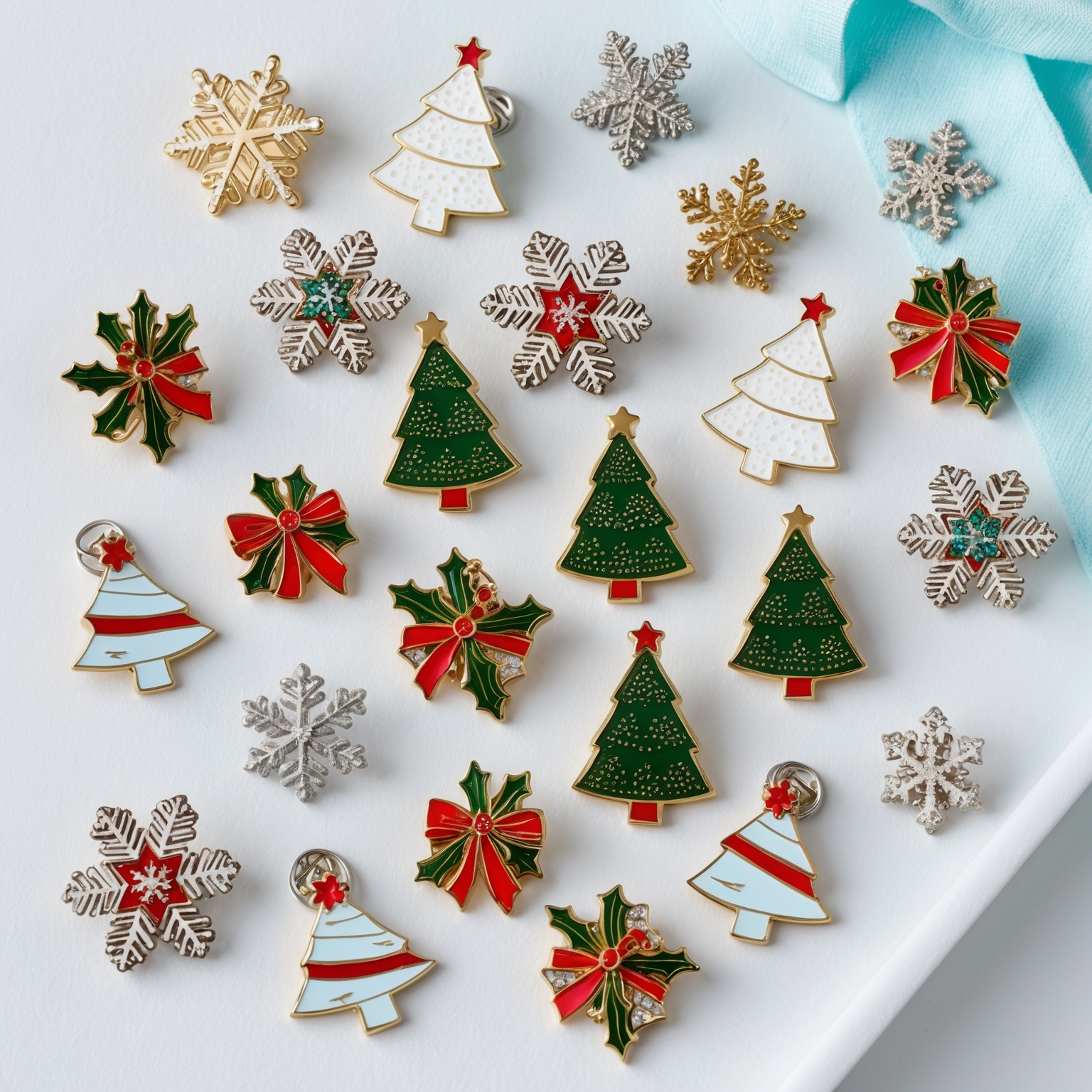Lapel pins are cherished collectibles that come in a vast array of designs and styles, often holding sentimental value and representing affiliations, achievements, or personal interests. However, the growing popularity of lapel pins has also led to an increase in counterfeit pins entering the market. For collectors, distinguishing genuine pins from fakes is crucial to preserving the integrity and value of their collections. In this comprehensive guide, we will explore nine essential tips for identifying fake lapel pins, helping collectors make informed purchases and avoid counterfeit items.
Lapel pins are small but meaningful accessories that have captured the hearts of collectors worldwide. From commemorating events and achievements to showcasing personal interests and affiliations, these pins serve as tangible symbols of identity and pride. However, the rise in demand for lapel pins has also attracted counterfeiters looking to profit from unsuspecting collectors.
Counterfeit lapel pins can range from poor-quality replicas to nearly indistinguishable copies of genuine pins. For collectors, the presence of fake pins in the market poses a significant challenge, as purchasing a counterfeit can devalue their collection and diminish the joy of collecting. Recognizing the signs of a fake lapel pin requires a keen eye and a deep understanding of the characteristics of genuine pins.
In this article, we will provide savvy collectors with nine essential tips for identifying fake lapel pins. By focusing on aspects such as craftsmanship, materials, markings, and provenance, collectors can develop the skills needed to spot counterfeit pins and make informed decisions. Whether you’re a seasoned collector or new to the hobby, these tips will help you navigate the world of lapel pin collecting with confidence and integrity.
1. Examine the Craftsmanship and Quality
The craftsmanship and quality of a lapel pin are key indicators of its authenticity. Genuine lapel pins are typically well-made, with attention to detail and high-quality materials. In contrast, fake pins often exhibit poor craftsmanship and inferior materials.
Inspect the Details
One of the first steps in identifying a fake lapel pin is to closely inspect the details of the design. Genuine pins are carefully crafted, with clean lines, precise edges, and sharp details. Look for any irregularities in the design, such as uneven lines, blurred images, or misshapen elements. These imperfections can be signs of a counterfeit pin.
Pay attention to the clarity of text and logos on the pin. Genuine pins often feature crisp and legible text, while fake pins may have fuzzy or poorly printed lettering. Additionally, check for any inconsistencies in the design elements, such as mismatched colors or incorrect logos.
Assess the Finish and Surface
The finish and surface quality of a lapel pin can also provide clues to its authenticity. Genuine pins typically have a smooth and even finish, whether they are polished, matte, or enamel-coated. The enamel should be evenly applied, with no bubbles, cracks, or gaps.
In contrast, fake pins may have a rough or uneven finish, with visible flaws such as scratches, dents, or discoloration. The enamel on counterfeit pins may appear lumpy or poorly applied, and the colors may be dull or inconsistent.
Check the Weight and Feel
The weight and feel of a lapel pin can vary depending on the materials used, but genuine pins often have a substantial and solid feel. They should not feel overly light or flimsy. Counterfeit pins, especially those made with cheaper materials, may feel lighter or less substantial.
Hold the pin and assess its weight and balance. A well-made pin should have a balanced weight distribution and feel sturdy in your hand. If the pin feels unusually light or poorly balanced, it may be a fake.
2. Examine the Materials and Construction
The materials and construction of a lapel pin are critical factors in determining its authenticity. Genuine pins are often made with high-quality materials and constructed with precision, while counterfeit pins may use cheaper alternatives and exhibit signs of poor construction.
Identify the Base Metal
The base metal used in a lapel pin can provide valuable information about its authenticity. Genuine pins are often made with durable metals such as brass, copper, or zinc alloy. These metals provide a solid foundation for the pin and contribute to its weight and durability.
In contrast, fake pins may use cheaper metals, such as aluminum or low-quality alloys, which can result in a lighter and less durable pin. Examine the metal parts of the pin, such as the back and edges, for signs of the base metal. If the metal appears thin, lightweight, or easily bendable, the pin may be counterfeit.
Evaluate the Plating and Coating
The plating and coating of a lapel pin are important aspects of its overall quality and appearance. Genuine pins often feature high-quality plating, such as gold, silver, nickel, or chrome, which gives the pin a polished and professional finish. The plating should be even and free of tarnish or discoloration.
Counterfeit pins may use inferior plating materials or techniques, resulting in a finish that looks cheap or uneven. Look for signs of poor plating, such as peeling, flaking, or discoloration. Additionally, check for any inconsistencies in the color or texture of the plating.
Inspect the Attachment and Backing
The attachment and backing of a lapel pin are also important factors to consider. Genuine pins typically use secure and reliable attachment mechanisms, such as butterfly clasps, rubber clutches, or magnetic backings. These attachments should be firmly affixed to the pin and provide a secure fit.
Fake pins may use low-quality or poorly attached backings, which can result in a loose or unstable fit. Examine the attachment mechanism for any signs of poor construction, such as loose parts, weak adhesives, or misaligned components. A genuine pin should have a sturdy and well-constructed backing that securely holds the pin in place.
3. Check for Official Markings and Hallmarks
Official markings and hallmarks are essential indicators of a lapel pin’s authenticity. These markings provide information about the pin’s manufacturer, origin, and authenticity. Knowing what to look for can help collectors verify the legitimacy of a pin.
Look for Manufacturer Marks
Many genuine lapel pins feature manufacturer marks, which indicate the company or artist that produced the pin. These marks are often found on the back of the pin and can include the manufacturer’s name, logo, or initials. Recognizing these marks can help collectors identify the pin’s origin and verify its authenticity.
Counterfeit pins may lack manufacturer marks or feature fake or altered marks. If you are familiar with the marks used by reputable pin manufacturers, you can use this knowledge to identify fake pins. If a pin lacks any manufacturer marks, it may be a red flag.
Check for Serial Numbers and Edition Information
Limited-edition and collectible lapel pins often include serial numbers or edition information, which indicate the pin’s place in a limited production run. These numbers are usually engraved or stamped on the back of the pin and can include details such as the edition number (e.g., “123/500”) or production date.
Genuine limited-edition pins typically have clear and legible serial numbers, while fake pins may lack these numbers or feature poorly executed engravings. If a pin is advertised as a limited edition but lacks serial numbers or edition information, it may be counterfeit.
Verify Hallmarks and Stamps
Hallmarks and stamps can provide valuable information about the materials used in a lapel pin, such as the metal content or plating. For example, genuine gold or silver pins may feature hallmarks indicating the metal’s purity (e.g., “14K” for 14-karat gold or “925” for sterling silver).
Check for any hallmarks or stamps on the pin and verify their accuracy. Counterfeit pins may feature fake or misleading hallmarks, so it’s important to know the correct markings for genuine materials. If you’re unsure about a hallmark, consider consulting a professional or using a hallmark reference guide.
4. Assess the Provenance and Source
The provenance and source of a lapel pin are important factors in determining its authenticity. Provenance refers to the history of ownership and origin of the pin, while the source refers to the seller or platform from which the pin is obtained.
Evaluate the Seller’s Reputation
When purchasing lapel pins, it’s crucial to consider the reputation and credibility of the seller. Reputable sellers, whether online or in-person, are more likely to offer genuine pins and provide accurate information about their products. Check the seller’s reviews, ratings, and feedback from other buyers to gauge their reliability.
If you’re buying from an online platform, such as eBay or Etsy, look for sellers with a high rating and positive reviews. Be cautious of sellers with little to no feedback or a history of negative reviews. Additionally, verify that the seller provides clear and detailed descriptions of the pins, including information about their authenticity and condition.
Request Documentation and Certificates
For high-value or collectible lapel pins, it’s important to request documentation or certificates of authenticity. These documents can provide valuable information about the pin’s origin, materials, and production. They can also serve as proof of authenticity, especially for limited-edition or artist-signed pins.
If a seller is unable or unwilling to provide documentation or certificates, it may be a red flag. Genuine sellers should have no issue providing the necessary paperwork, especially for valuable or collectible items.
Consider the Price and Value
The price of a lapel pin can also provide clues to its authenticity. Genuine pins, especially limited-edition or collectible ones, often have a higher market value. If a pin is being sold at an unusually low price, it may be a counterfeit.
However, it’s important to note that a high price does not guarantee authenticity. Some counterfeiters may price fake pins similarly to genuine ones to deceive buyers. Always consider the price in conjunction with other factors, such as the seller’s reputation, documentation, and the pin’s overall quality.
Conclusion
Identifying fake lapel pins is a crucial skill for collectors who want to ensure the integrity and value of their collections. By carefully examining the craftsmanship, materials, markings, provenance, and source of a pin, collectors can develop the knowledge and confidence needed to distinguish genuine pins from counterfeits.
While counterfeit pins can be convincing, paying attention to the details and conducting thorough research can help collectors make informed decisions. Whether you’re purchasing a pin as a gift, a collectible, or a personal keepsake, taking the time to verify its authenticity is essential.
As the market for lapel pins continues to grow, collectors must remain vigilant and educated. By following these nine essential tips, savvy collectors can protect their investments and enjoy the thrill of collecting genuine and meaningful lapel pins. Whether you’re new to the hobby or an experienced collector, these tips will help you navigate the world of lapel pins with confidence and expertise.
If you are interested in some custom lapel pins, feel free to contact us at 1-855-471-6752 or fill out one of our FREE QUOTE FORMS.



